Quick, name one thing that goes exceptionally well with chocolate. My reflexive answer is peanut butter (yes, I’m one of those sweet and salty types), but Brian Pfeiffer makes a case for the answer being Paris. I’m delighted to publish his description of the annual Salon du Chocolat in Paris. Brian and I share not only a fence (we’re neighbors) but also common interests in food and travel. An architectural historian, Brian is an expert on historic preservation. He’s equally talented at preserving an appreciation of life’s grandest pleasures, chocolate and Paris among them. ~Marjorie
Salon du Chocolat in Paris
Text and photos by Brian Pfeiffer
Why did I do it? I have no idea, except that it was there, looming in front of me at every turn, on posters on the fronts of buses, in magazines and on television news. If you are in Paris at the end of October, the Salon du Chocolat is inescapable. Billing itself as “the largest event in the world dedicated to chocolate,” the Salon’s 5 acres of floor space and more than 200 exhibitors beg, like Mt. Everest, to be conquered, if for no other reason than its vastness – and, of course, the promise of samples.
What began twenty years ago as a trade show celebrating the prowess of French chocolate-making has grown into an enormous international enterprise with Salons du Chocolat taking place in eight cities throughout France and in locations as far-flung as Shanghai, Beirut, Moscow and New York, but the Paris show is the mother lode for anyone who wants to experience the latest in chocolate invention, refinement and, dare I say it? Kitsch.
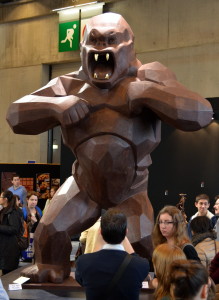
“Le Kong” – the 800-pound gorilla that greets visitors to the Salon du Chocolat (by Jean-Paul Hévin)
A cautionary note to the wise, the Salon is both a wildly popular public event and a trade show. Opening time (10 am) offers the best opportunity to stroll calmly, observe chocolatiers and financial backers sizing up each other for future ventures, and meet individual chocolatiers who are delighted to discuss their products. On my first visit, I made the mistake of arriving at the time of the fashion show when the hall was packed to capacity. Dozens of emaciated models in need of a good meal strut the catwalk in potentially nourishing costumes designed by couturiers and made in chocolate. Among the anecdotes of past shows, the Salon du Chocolat cites melting costumes that left models unclothed in public as a source of merriment for all – a version of Janet Jackson’s infamous “wardrobe malfunction” but with public approval instead of priggish tongue clucking. The French really are different from us. Despite the enormous skill that these creations represent, they beg the question of why bother; it’s a bit too close to playing with one’s food. Still, if you are curious, get there early for a ringside seat.
Samples are offered everywhere and, although they are prudently small, they mount up, so pace yourself to avoid one of those famous and uniquely French crise de foie (essentially an upset stomach attributed to a disgruntled liver). After an initial feeding frenzy, I settled on a formula of trying only chocolates with flavorings I had never previously had or sampling classic dark chocolate that provides a baseline for assessing the likely quality of a chocolatier’s other offerings.
The show’s entry and central aisle are dominated by the large, well-known chocolate producers. I recommend moving to the side aisles where individual chocolatiers offer products that cannot be tasted anywhere else except in their shops.
Among the most interesting exhibitors are those who have combined good confection with humanitarian, ecological and gastronomic goals. None embodies these virtues better than Erithaj Chocolates, a firm that grows out of a three-way collaboration among André Stengel who, in his retirement, founded Vietcacao to aid Vietnam in re-establishing cocoa production, his son, Arnaud, who established Erithaj Chocolates to produce chocolate from single-source Vietnamese cocoa, and Franck Morin, a fourth generation chocolatier whose firm confects the chocolate. For the Salon, Erithaj produced several different chocolates from the same beans roasted under slightly different conditions to demonstrate the various qualities that could be coaxed from them.
A very different approach is represented by the nearly evangelical Frédéric Marr of Rrraw Chocolates whose somewhat tongue-in-cheek motto is “Save the Earth – it’s the only planet with cocoa!” Springing from the American raw food movement, Marr does not roast his cocoa beans to the traditional temperature of 140°-160° centigrade. Instead, he dries them at no more than 45° centigrade to produce a chocolate that is somewhat drier and less creamy/fatty in texture. A few booths away, Korea’s HwangHu chocolates offered chocolate fermented in several stages. Included in the fermentation and final production are various types of cheeses, herbs and flowers that add distinctive flavors. The chocolates are packaged in beautiful ceramic pots which allow the chocolate to “breathe” and the flavors to continue to develop for up to three months.
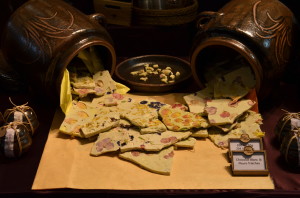
HwangHu Chocolates- fermented white chocolate with flower petals and the pottery that contributes to their fermentation
More traditional chocolates of extraordinary quality were offered by Guy Perault of Orangettes & Company who stood in front of his booth offering samples of chocolate-covered citrus peels. He starts from scratch by candying organic orange, grapefruit and other citrus peel before coating it in gleaming dark chocolate. He announces without hesitation that his chocolate-covered citrus peel is the best available anywhere, and it is a credible claim.
Anne-Françoise Benoit, proprietor of Benoit Chocolatier, promotes her finely ground almond praline in dark and milk chocolate which is memorable for its subtle crunch and caramelized almond flavor. Not least among the small producers is Bello & Angeli from Toulouse whose elegant glass globes were filled with the finest and most delicately roasted hazelnuts and almonds I have ever tasted. Coated with a thin crunch of sugar, bedded on dark chocolate or mixed with candied orange peel, these treats are worth a detour.
Among the show’s surprises was the strong showing by Japanese chocolatiers, many of whom were trained in France. Tending to associate Asian tastes with the non-sweet flavors – salty, sour, bitter and the incomprehensible “umami,” I had not realized the extent to which western tastes for pastry and confection had invaded Japan and Korea. Few places on earth are as closely matched for cultural and artistic refinement as France and Japan, as is evident from the displays, most notably of Sadaharu Aoki where elegant confections flavored with wasabi, bamboo and passion fruit are arranged in rainbow colored rows.
Being quick to judge and equally quick to regret, I initially avoided what seemed to me novelty items such as chocolate pizza, cookies by the scoop and caramel popcorn until I came to the small stand of Mukaiyama Seisakusho where the only products offered were caramel covered popcorn and caramels. It seemed out of place, so I stopped to talk with the tri-lingual clerks who explained to me that caramel popcorn and pancakes are having a current vogue in Japan. However, do not imagine that the Japanese are munching down sticky Cracker Jack – it’s far too unrefined for their tastes. Instead, the popcorn is coated with a microscopically thin, crisp layer of caramel flavored with various ingredients of which the black pepper popcorn provided a subtle bite that increased over time. The caramels are formulated to eliminate the stickiness that makes most caramels a dental nightmare, and they are flavored with cherry blossoms cured in salt (my personal favorite), basil and the indescribably fragrant/spicy flavor of perilla leaves.
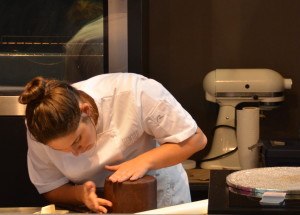
How to achieve a perfectly smooth chocolate cake covering – one of the many ongoing demonstrations of pastry-making and decoration
Be sure to allow time for the exhibition hall’s lower level where cooking and pastry demonstrations vie for attention with elaborate chocolate sculptures (including a huge gorilla – le Kong), exhibitions on the history, ecology, and economic impact of chocolate, and even cocoa-based cosmetics. Don’t miss one small quiet booth operated by Société des Meilleurs Ouvriers de France. Since 1990, the Société has awarded the title of Meilleur Ouvrier de France Chocolatier-Confiseur to a handful of chocolatiers who have passed a rigorous examination to demonstrate their work skill, the quality of the chocolate they produce and their ability to create a stunning masterwork. Unlike the United States where we are in constant search of “The Best of….” those who pass this examination call themselves “one of the best…” (“Un des Meilleurs Ouvriers de France”) Although it seems a modest claim for such skill, it is accurate – how can one distinguish meaningful differences among chocolatiers who work at this level?
My favorites: I cannot claim to have been comprehensive in my sampling, but my tastes are clear – I prefer nuts & chocolate and citrus peel & chocolate to fruit creams & chocolate. With this disclaimer, I offer a list of chocolatiers who caught my attention:
Erithaj was founded by Arnaud Stengel whose father, André, has worked to re-establish cocoa production in the Mekong Delta, both to help farmers achieve greater independence in managing and creating crops of commercial value and to help train handicapped Vietnamese to high-skilled jobs. It is an admirable enterprise, and the gastronomic results are excellent.
Bello & Angeli won me immediately with its superbly roasted and lightly caramelized hazelnuts bedded in milk and dark chocolate. Traveling to Toulouse is a small price to pay for these treats.
Benoit – owned and operated by a chocolatière – that is to say one of the very few women who have become master chocolatier – the French don’t normally feminize the names of professions, but in this case, Anne-Françoise Benoit does in justifiable pride at her achievements. Among the best of her chocolates is a delicate praline crushed to a light crunch and blended into light and dark chocolate bark.
Sadaharu Aoki trained in Tokyo and Paris where he has multiple shops including an elegant kiosk at the Galeries Lafayette and tea rooms offering beautifully presented and chocolates subtly flavored with bamboo, wasabi and yuzu, but the best (for my taste) is the matcha tea and toasted sesame in white chocolate. The website is charmingly frustrating – click on English and you will be taken to pages with mixed English and Japanese text – but the pictures transcend language.
Orangettes & Company is the creation of chocolatier Guy Perault, who announced with conviction, pride and no arrogance that he produces the best chocolate-covered orange peel available anywhere. He may well be right. Try the grapefruit, lemon, ginger & apricot as well.
Mukaiyama Seisakusyo, Ltd. was one of several small confectioners who came to the show for wider exposure and in search of backers to help it make the leap into the European market. Currently only available in Japan, the company has an exotic history, having begun as an electronic parts manufacturer that suffered in the economic downturn of 2008 and turned to making their Nama Caramels in the factory kitchen as a way of holding its business together. In 2009, the firm opened its first shop in Fukushima only to have the business destroyed in the earthquake. They are back in business producing delicious caramels and caramel popcorn.
Rrraw is the creation of Frédéric Marr, a chocolatier with a mission: “Save the Earth, it’s the only planet with cocoa.” Inspired by the raw food movement in the USA, Marr produces chocolate without roasting the beans to the customary temperature. The benefits, he believes, are improved nutrition and good flavor. His chocolates are not startling different in flavor from the standard method, but they are less sweet and less melting in texture. The jury is still out, but I am intrigued.
Chocolates HwangHu is a two-year old Korean company with the philosophy of using local products, encouraging employee development and using a special fermentation process in three steps, the last of which occurs in breathable pottery that doubles as the product packaging. The white chocolate with flowers was very interesting and different in texture from most white chocolate, although I am not sure I really understand the explanation of the fermentation process, as the representatives spoke little English and even less French.
The 2015 dates for the Paris Salon du Chocolat are 28 October – 1 November at the Porte de Versailles. For a list of other upcoming Salons du Chocolat, click here.
Brian Pfeiffer is an architectural historian who nominally lives in Cambridge, Massachusetts where he plots his frequent escapes to Paris in an ongoing quest for chocolate to fortify his wanderings.

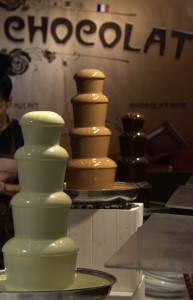
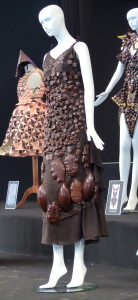
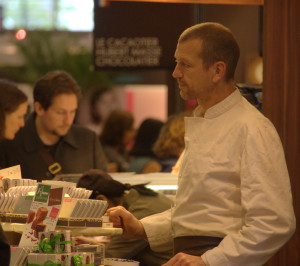
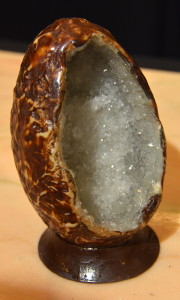
1 comment. Leave new
Brian,
We share something in common besides preservation: not a love of chocolate but an addiction. Your description of the offerings at the Salon du Chocolat were so vivid, I could taste them. And I received this e-mail after having just returned from a special trip to Cardullo’s in snow and sleet to buy Scharffen Berger Cocoa so I could make my favorite drink.
Hope you will return home soon and stay long enough, so I can see you.
Pebble